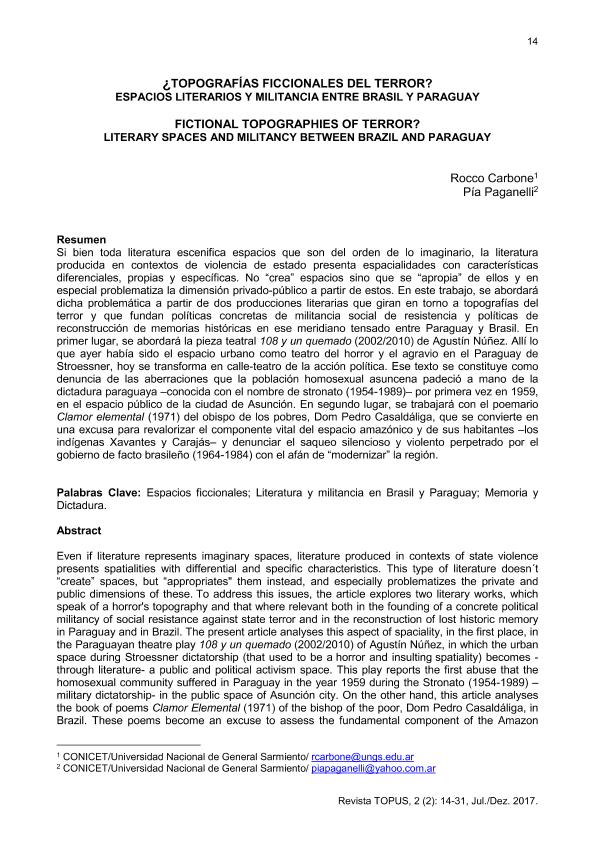Mostrar el registro sencillo del ítem
dc.contributor.author
Carbone, Rocco

dc.contributor.author
Paganelli, Pía

dc.date.available
2022-11-30T17:47:25Z
dc.date.issued
2016-12
dc.identifier.citation
Carbone, Rocco; Paganelli, Pía; ¿Topografías ficcionales del terror? Espacios literarios y militancia entre Brasil y Paraguay; Universidade Federal do Triângulo Mineiro; Topus; 2; 2; 12-2016; 14-31
dc.identifier.issn
2448-2978
dc.identifier.uri
http://hdl.handle.net/11336/179597
dc.description.abstract
Si bien toda literatura escenifica espacios que son del orden de lo imaginario, la literatura producida en contextos de violencia de estado presenta espacialidades con características diferenciales, propias y específicas. No “crea” espacios sino que se “apropia” de ellos y en especial problematiza la dimensión privado-público a partir de estos. En este trabajo, se abordará dicha problemática a partir de dos producciones literarias que giran en torno a topografías del terror y que fundan políticas concretas de militancia social de resistencia y políticas de reconstrucción de memorias históricas en ese meridiano tensado entre Paraguay y Brasil. En primer lugar, se abordará la pieza teatral 108 y un quemado (2002/2010) de Agustín Núñez. Allí lo que ayer había sido el espacio urbano como teatro del horror y el agravio en el Paraguay de Stroessner, hoy se transforma en calle-teatro de la acción política. Ese texto se constituye como denuncia de las aberraciones que la población homosexual asuncena padeció a mano de la dictadura paraguaya –conocida con el nombre de stronato (1954-1989)– por primera vez en 1959, en el espacio público de la ciudad de Asunción. En segundo lugar, se trabajará con el poemario Clamor elemental (1971) del obispo de los pobres, Dom Pedro Casaldáliga, que se convierte en una excusa para revalorizar el componente vital del espacio amazónico y de sus habitantes –los indígenas Xavantes y Carajás– y denunciar el saqueo silencioso y violento perpetrado por el gobierno de facto brasileño (1964-1984) con el afán de “modernizar” la región.
dc.description.abstract
Even if literature represents imaginary spaces, literature produced in contexts of state violence presents spatialities with differential and specific characteristics. This type of literature doesn´t “create” spaces, but “appropriates" them instead, and especially problematizes the private and public dimensions of these. To address this issues, the article explores two literary works, which speak of a horror's topography and that where relevant both in the founding of a concrete political militancy of social resistance against state terror and in the reconstruction of lost historic memory in Paraguay and in Brazil. The present article analyses this aspect of spaciality, in the first place, in the Paraguayan theatre play 108 y un quemado (2002/2010) of Agustín Núñez, in which the urban space during Stroessner dictatorship (that used to be a horror and insulting spatiality) becomes - through literature- a public and political activism space. This play reports the first abuse that the homosexual community suffered in Paraguay in the year 1959 during the Stronato (1954-1989) – military dictatorship- in the public space of Asunción city. On the other hand, this article analyses the book of poems Clamor Elemental (1971) of the bishop of the poor, Dom Pedro Casaldáliga, in Brazil. These poems become an excuse to assess the fundamental component of the Amazon space and its inhabitants –native communities Xavantes and Carajás– and denounce the silent and violent looting perpetrated by the de military government (1964-1984) in an effort to "modernize" the region.
dc.format
application/pdf
dc.language.iso
spa
dc.publisher
Universidade Federal do Triângulo Mineiro
dc.rights
info:eu-repo/semantics/openAccess
dc.rights.uri
https://creativecommons.org/licenses/by-nc-sa/2.5/ar/
dc.subject
ESPACIOS FICCIONALES
dc.subject
LITERATURA BRASIL Y PARAGUAY
dc.subject
MILITANCIA POLÍTICA
dc.subject
DICTADURA Y MEMORIA
dc.subject.classification
Estudios Generales de Literatura

dc.subject.classification
Lengua y Literatura

dc.subject.classification
HUMANIDADES

dc.title
¿Topografías ficcionales del terror? Espacios literarios y militancia entre Brasil y Paraguay
dc.title
Fictional topographies of terror? Literary spaces and militancy between Brazil and Paraguay
dc.type
info:eu-repo/semantics/article
dc.type
info:ar-repo/semantics/artículo
dc.type
info:eu-repo/semantics/publishedVersion
dc.date.updated
2022-11-29T13:10:45Z
dc.journal.volume
2
dc.journal.number
2
dc.journal.pagination
14-31
dc.journal.pais
Brasil

dc.journal.ciudad
Uberaba
dc.description.fil
Fil: Carbone, Rocco. Consejo Nacional de Investigaciones Científicas y Técnicas; Argentina. Universidad Nacional de General Sarmiento. Instituto del Desarrollo Humano; Argentina
dc.description.fil
Fil: Paganelli, Pía. Consejo Nacional de Investigaciones Científicas y Técnicas; Argentina. Universidad Nacional de General Sarmiento. Instituto del Desarrollo Humano; Argentina
dc.journal.title
Topus
dc.relation.alternativeid
info:eu-repo/semantics/altIdentifier/url/http://www.revistatopus.com.br/en/archives__.asp?cod=41&edicaoCod=4
Archivos asociados
